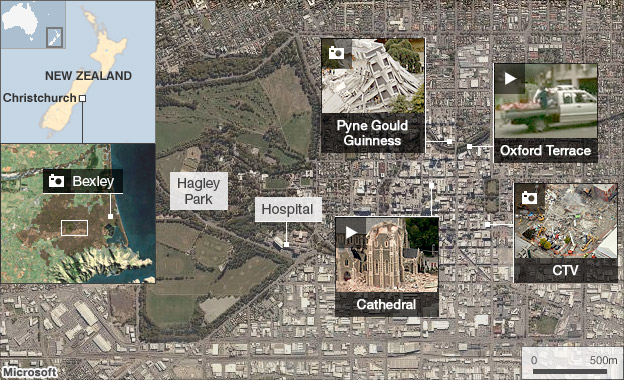Christchurch earthquake: Mayor Parker praises rescuers
- Published
Christchurch mayor, Bob Parker: "Spirits are remarkably good"
The mayor of Christchurch has praised the "incredible progress" made four days after a massive earthquake rocked the New Zealand city.
Bob Parker told the BBC that spirits among hundreds of rescue workers from eight nations were "remarkably good".
The death toll from Tuesday's 6.3 magnitude tremor stands at 144, with more than 200 still missing.
Rescuers admit the chance of finding survivors is now slim; none has been pulled from the ruins since Wednesday.
Meanwhile, officials have warned that a third of the buildings in the city centre may need to be demolished and rebuilt.
Hundreds of suburban homes are also thought to be too damaged to save.
Mr Parker said energy supplies around the city were running at around 50% capacity, and that the rest of the city would be connected within days.
"The structure of the city has received a shattering blow, but we're making incredible progress," Mr Parker told BBC World News on Saturday. "It's a very difficult situation but, given what we're going through, spirits are remarkably good."
"There's no such thing as normality; there are major incidents every hour, but we're totally focused and it's a world-class operation that we have here."
Hope fading
Shuddering aftershocks hampered rescue efforts on Saturday as some 600 emergency workers from New Zealand and the UK, the US, China, Taiwan, Japan, Mexico and Australia scoured the devastated city for survivors - but found only bodies.
With the slow process of identifying the dead underway - only six people have been formally identified so far - rescuers believe multiple bodies remain trapped beneath three collapsed structures.
Officials believe up to 22 bodies may lie beneath the rubble of Christchurch Cathedral; as many as 120 are thought to have been killed inside the collapsed CTV office block, including Japanese, Chinese and Philippine nationals; many more are presumed dead inside the destroyed Pyne Gould Guinness building.
The BBC's Rachel Harvey explains how rescuers mark buildings they search
Earlier on Saturday New Zealand's Foreign Minister Murray McCully said: "The rescue focus is drawing towards a conclusion... We're getting to the end of that period in which you can still have hope."
Families of the missing have appealed for the identification process to be accelerated, but officials are using DNA identification and have asked for patience.
Relatives of missing foreign nationals have also been arriving from overseas.
Power has been restored to most of the city but water supply remains a problem, with residents being urged to boil water for drinking or cooking due to contamination fears.
Roads have been damaged by liquefaction - where the earth loses its strength because of the shaking.
Although Christchurch's last major earthquake in September 2010 was more powerful, officials said the process of liquefaction was up to 500% worse this time.
Troops and police are out in force in the city, and 300 Australian police officers have been drafted in to assist after looting was reported in some places.
The quake - New Zealand's deadliest natural disaster for 80 years - struck at a shallow depth of 5km (3.1 miles) early on Tuesday afternoon, when the South Island city was at its busiest.
CLICKABLE Select the images for more details.

Bexley

Streets in the north-eastern suburb of Bexley were flooded as the quake caused water mains to burst, which coincided with heavy rain.
Pyne Gould Guinness

The multi-storey Pyne Gould Guinness Building, which normally houses around 200 workers, collapsed. A number of people were thought to be trapped inside.
Cathedral

The 63m spire of the city's Anglican cathedral was toppled by the earthquake. A New Zealand TV reporter took a look inside the damaged building.
CTV building

Part of Christchurch's Canterbury Television [CTV] building completely collapsed in the earthquake. Some 24 people have been rescued from the building, but police said there might be between 60 and 120 bodies trapped underneath.
Oxford Terrace

In the aftermath of the earthquake, Rhys Taylor took this video on Oxford Terrace, 50 metres away from the city's main hospital. He said: "Cars were being used as ambulances to transport the injured."
- Published25 February 2011
- Published24 February 2011
- Published23 February 2011
- Published23 February 2011